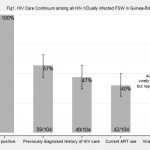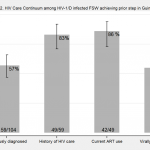(P13) The HIV Care Continuum among female sex workers in Guinea-Bissau, West Africa
Författare/Medförfattare
Jacob Lindman [1], Mamadú Aliu Djaló [2], Ansu Biai [3], Fredrik Månsson [4], Zacarias da Silva [3], Marianne Jansson [5], Joakim Esbjörnsson [5], Patrik Medstrand [6], Hans Norrgren [1] for SWEGUB CORE group
Affiliates
The Department of Clinical Sciences Lund, Lund University, Sweden [1], Environment development action in the third world (ENDA), Bissau, Guinea-Bissau [2], The National Public Health Laboratory, Bissau, Guinea-Bissau [3], Department of Clinical Sciences Malmö, Lund University, Sweden [4], The Department of Laboratory Medicine, Lund University, Sweden [5], The Department of Translational Medicine, Lund University, Sweden [6]
Abstract
Background
Linkage to care, ART initiation, adherence and treatment outcomes have not been well characterized among HIV infected female sex workers (FSW) in West Africa. Guinea-Bissau is a country with poor adherence results and a report from an HIV clinic in the capital Bissau showed that more than half of patients attending the clinic in 2005-2012 had been lost to follow-up. In this study we aimed to describe the HIV Care Continuum among FSW in Guinea-Bissau.
Methods
In collaboration with ENDA Santé, we used venue based sampling to enroll FSW in 8 cities in Guinea-Bissau from October 2014 to September 2017. Blood samples were drawn and screened on-site with HIV rapid testing. Participants completed a survey that included demographic factors, sexual risk behavior and treatment status. CD4 counts, HIV type discrimination and viral load was performed. Proportions and 95 % confidence intervals were computed for the four continuum outcomes; previous diagnosis, history of HIV care, current ART use and viral suppression (<1000 copies/ml). These continuum outcomes was estimated by two different approaches; using all HIV-1/Dually infected FSW as the denominator and by using HIV-1/Dually infected FSW achieving the prior step in the continuum as the denominator. Poisson regression was used to investigate the associations of demographics and transmission risk behavior with each continuum outcome.
Results
Among the study population (n=440), the median age was 28 years (IQR 22-35). Nearly one third had no schooling and the majority (88%) were single, divorced or widowed. The median duration of sex work was 12 months (IQR 6-24). 45 % reported inconsistent condom use during vaginal sex in the last month. The median number of clients the past day was 1 (IQR 1-3). Total HIV seroprevalence was 27% (n=118) (HIV-1 21% (n=90), HIV-2 3 % (n=14) and HIV-dual infection 3% (n=14)), with pronounced differences between the regions. In the capital Bissau the total HIV-prevalence was 36%. The HIV care continuum among all HIV-1/dually infected FSW and among HIV-1/dually infected FSW achieving the prior step in the continuum is presented in figure 1 and 2 respectively. Demographics and transmission risk behavior were not associated with outcomes along the HIV care continuum, except age ≥ 30 years which was associated with a higher prevalence of previous HIV diagnosis.
Conclusion
FSW in Guinea-Bissau are heavily HIV burdened and nearly half were unaware of their HIV infection. Less than half of HIV-1/dually infected FSW had a history of HIV care but of them most reported still being engaged in care and on ART. Among FSW on ART, just over half were virally suppressed. Our study suggests that there is an enormous need for increased HIV prevention efforts, HIV testing and linkage to care, improved ART coverage and interventions to increase ART adherence as well as improved clinical outcomes in FSW in Guinea-Bissau.

